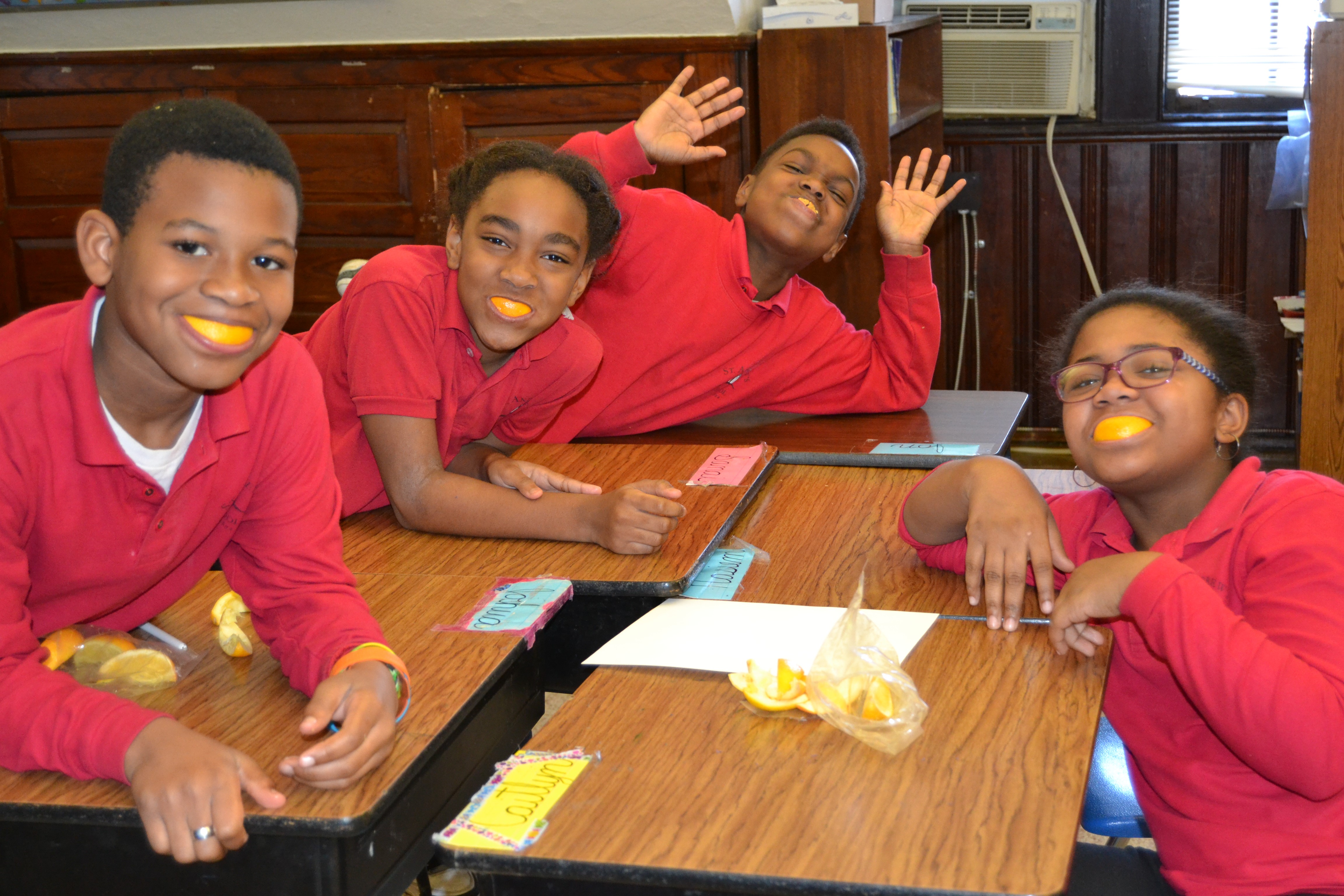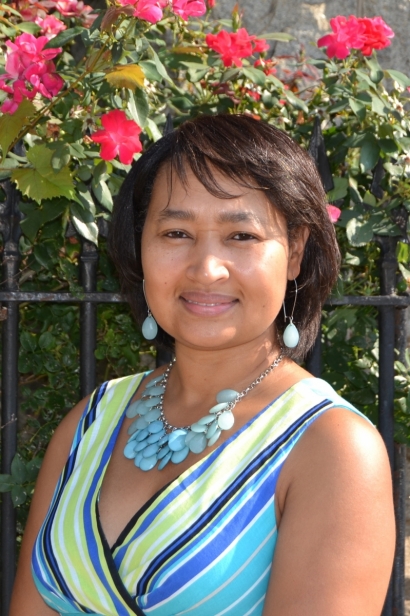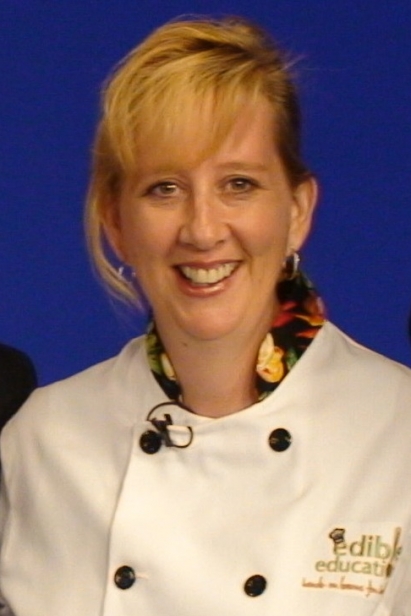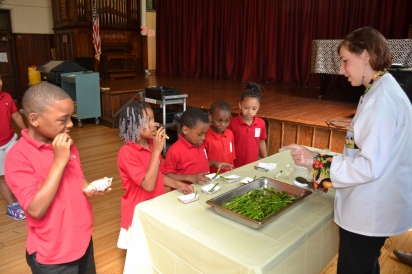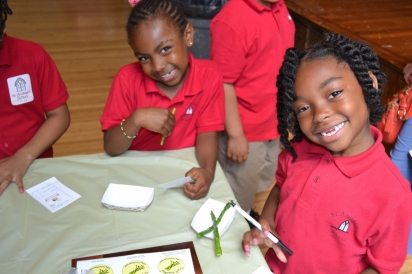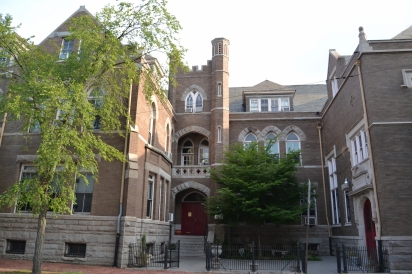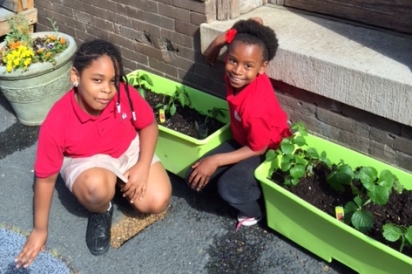Meet the New Lunch Ladies
Mario approaches the table cautiously, a big kindergartner with café au lait skin and tight brown curls, eyeing the small paper cups of bright asparagus spears. He says that he’s had asparagus before, but not sautéed in olive oil. His classmates on lunch break are enthusiastically gobbling down the taste-test treats, but Mario chews one spear at a time, thoughtfully. Then he grips a blue crayon and carefully marks “liked it” and “would try again” on a feedback form.
The asparagus will be back, thanks to its high taste-test marks. St. Andrew’s School also serves beets, jicama, kale and radishes along with plenty of other, equally radical local produce, and nobody has to chide even hesitant eaters like Mario to eat their greens. In fact, the salad bar is just as popular as the hot lunch option.
How is an elementary school that serves an economically challenged population managing to get kids to love vegetables? At a time when school lunches are still receiving failing grades for both nutrition and flavor, St. Andrew’s students (and teachers) enthusiastically clean their plates at daily breakfast and lunch. The successful program is serving as a model for Richmond City Schools, which is piloting a similar program this fall. In fact, St. Andrews’ success could spice up school lunches nationwide.
Why Kids Will Actually Eat Quinoa
Cyndy Weldon-Lassiter arrived in July 2010 to serve as head of school at St. Andrew’s. She is a compact, confident woman with mixed African American, Asian, Native American and white heritage who had teaching and administrative chops from Collegiate, Chesterfield Public Schools and schools in New Jersey. She looked good on paper but parents—primarily African American and 70% of them single moms, according to Lassiter—wanted to get to know her personally in one-on-one meetings.
In one of her parent meetings, a mom asked why the school didn’t have a school lunch program. “She told me she was packing her son a cheese sandwich every day because that’s what she could afford,” Lassiter says. “And he was so sick of cheese sandwiches.” When Lassiter visited the lunchroom she saw lots of fast food, sodas and sugary drinks. A mom of three herself, Lassiter spotted nutritional deficits that she suspected were affecting the students’ ability to learn. Well, she asked herself, why aren’t we doing lunch?
Lassiter is a former military brat who knows how to move into a new situation and take charge. By her second year at St. Andrew’s she had breakfast up and running. The following year the school added lunch, and then morning and afternoon snacks. Last year, St. Andrew’s partnered with Edible Education (not related to Edible Richmond) and Field of Dreams Farm to go whole hog with cooking from scratch using fresh local produce, offering cooking classes to students and parents and even growing some vegetables at the school.
On a recent weekday morning in the St. Andrew’s kitchen there wasn’t a can in the room. Instead, prep pans overflowed with local strawberries, cucumbers and tomatoes. Chef Jilnelle Bishop from Edible Education had her brown hair tucked under a hair net and was frying up some cornmeal-dusted whiting fillets. A peach cobbler with a whole-wheat crust cooled nearby. Earlier that month Bishop had served the kids dishes with quinoa, jicama and tofu, which, she says, they loved.
Ann Butler started Edible Education in 2010 to teach kids about cooking and healthy eating. She says that it takes seven months of trying for a group of kids to buy into a new food, and the key is offering them some control along the way. “The salad bar is a big hit,” Butler says. “And one reason is because the kids can choose their own foods.” If radishes keep showing up on the salad bar, she says, eventually kids are going to try a radish.
Butler organized the weekly taste tests so the students have some input. “We can’t say, ‘Eat the asparagus, it’s really good for you.’ That doesn’t fly, kids are smarter than that,” says Butler. “Instead we have to say, ‘We have asparagus from our farmer, you need to tell us do you want it roasted or with a balsamic reduction.’” With the feedback forms, Butler also gives St. Andrew’s kids the power to sometimes vote down a taste-test food completely—beets, for example, probably won’t be coming back (except mixed with ground beef in popular “beetburgers”).
School Kitchens Need Sprucing Up
There is growing national pressure for school programs like this. British chef Jamie Oliver seems to be spending his career urging and rewarding American schools for improving their lunches. Alice Waters, founder of Chez Panisse, sponsored a school garden-and-lunch program two decades ago in Berkeley, California, which has had well-documented success.
So, why aren’t more schools in Richmond, or Selma, or Tallahassee following suit?
A handful of reasons: First, the Federal school lunch program, established in the 1950s, has gotten so far away from actual cooking that kitchen staff doesn’t have the necessary training. Many of today’s lunch ladies know how to open cans and press microwave buttons, but not much more. Hiring trained cooks means paying higher salaries—something not every school district can afford.
Second, those new cooks may not have the right equipment. After years and years of can-opening, many school kitchens don’t even have ovens, griddles, steam kettles, tilt skillets and other institutional cooking equipment. If they do, it’s highly likely that it badly needs repairs.
And finally, there is the USDA. St. Andrew’s launched their program by applying for foundation grants and also USDA school lunch funding. The challenge with USDA funding is that it only subsidizes USDA-approved foods, which have historically been canned, frozen and pre-cooked commodity items.
At St. Andrew’s, only about 40% of the program’s funding today comes from the USDA—the other 60% comes from grants and private donations. Although Lassiter estimates that 90% of her families live near the poverty level, St. Andrew’s is a private school (tuition is free for accepted students). As such, the school has a donor base and the resources to apply for grants. That 40% of USDA funding is what pays for Chef Bishop and some core foods, like the frozen whiting fillets, flour and beans. The remaining 60% of private and grant money is what pays for the fresh, local produce from Farmer Greg at Field of Dreams Farm.
Happily, the USDA is finally adapting to offer schools some fresh opportunities. Since 2009 the agency has awarded $160 million in grants to schools for kitchen equipment. And the Healthy, Hunger-Free Kids Act of 2010 has led to programs like the USDA “Farm to School” initiative, launched in 2012 to help schools get better access to local produce. The initiative has funded school gardens and school partnerships with local growers and farmers nationwide.
The ROI of Better Food
Strapped for cash like any school, St. Andrew’s chooses to spend significant funds on food that it could instead invest in books, teachers or new curriculum.
“Healthy brain-friendly food has such a huge impact on children’s ability to learn at school,” Lassiter says. “Here they get protein, fresh fruit and vegetables for healthier bodies. We see a different behavior in the afternoons now. There is more focus and concentration, and the afternoons are a good learning time.”
Ann Butler points out further-reaching benefits. “My parents both smoked, and we learned in school smoking is bad,” she says. “So as kids we’d go home and say, ‘You have to stop smoking, we learned that in school today.’ You can educate an entire family by teaching a child.”
St. Andrew’s built a family education component by offering monthly cooking classes both in school for kids and after school for parents. The kids also grow vegetables in pots on the schoolyard blacktop during the fall and spring, and Butler says they are more willing to try foods that they’ve grown themselves.
The anecdotal evidence is compelling, but study results are even more convincing about the return on this investment. Kids eat healthier options when chefs are cooking the food, according to a study released in March 2015 from Harvard’s T. H. Chan School of Public Health. The study placed chefs in 14 urban elementary and middle schools to cook fresh lunches from scratch. After three months students were eating 8% more vegetables, and that jumped to 17% after four months. The study’s topline message to schools: Keep trying, even if the kids resist at first.
St. Andrew’s has commissioned its own study, working with independent researchers to create a comprehensive measure of the program’s results. The study polled students and parents at the beginning and end of last school year to identify changes in a wide range of factors including fresh fruit and vegetable consumption both at school and at home.
Imitation is the sincerest form of flattery, and this fall Richmond Public Schools is piloting a lunch program in one school that is modeled after the one at St. Andrew’s, and in addition to planting 20 garden patches for school use. RPS is funding the program with a $45,000 grant from the USDA’s Farm to School initiative.
In other words, there is hope that when Mario reaches middle school he may still be able to get local asparagus sautéed in olive oil at lunchtime.


